Transito Site
By Geoffrey McCafferty (2008)
During the summer of 1993 a collaborative research project between the Puebla Regional Center and Brown University was initiated when a group of Brown students under the direction of Geoffrey McCafferty assisted Sergio Suárez in the excavation of an Early Classic period house. The site, designated R-106, was discovered as part of a rescue excavation prior to construction. In the initial trench (Cala 1) a burial cache of Classic period pottery was found, as was part of a stucco floor (Floor 1) at a depth of 50 cm below the surface. Cala 2 discovered an additional section of floor with associated wall remains. At this point, however, the excavation was suspended until the field crew from Brown University arrived. Over a period of four weeks an area of 40 square meters was exposed, including features associated with the floor, a related subfloor tomb, and a variety of Postclassic and Colonial period midden deposits (Fig. 1). During two subsequent weeks labwork was conducted on the materials recovered, including cleaning and labelling of the artifacts, skeletal and ceramic analysis, and photography and illustration of the artifacts.

Plan of Transito site
The structure featured a thick stucco floor and adobe walls with some evidence for painted plaster. Due to post-depositional disturbance the complete structural plan could not be identified. Exterior walls were encountered on the west and east sides, but floors were broken to the north and south. The east wall was preserved as a low talud with indications that it had been rebuilt at least once. The structure consisted of at least two rooms with an adobe interior wall and well-preserved doorway connecting the floor areas that were at slightly different levels (Fig. 2). The doorway retained the outline of jamb posts in the stucco surface. Based on the relatively small size of the structure and the presence of internal divisions, this structure is interpreted as a house. Figure 2: Floor and dividing wall Floor 1 was only about 50 cm beneath the surface, and consequently the deposits above the floor were disturbed plow-zone with diagnostic artifacts ranging from the Classic period to the present, but with the majority representing the Postclassic period. A thin layer of yellow-brown adobe "melt" was occasionally found directly above the stucco floor, with Classic period ceramics embedded in it. In other areas, however, plow scars in the stucco indicated that disturbance was more profound. In order to recover artifacts that could more accurately date the structure, 1x1 m pits (pozos) were dug through the floor in areas where intact stucco suggested minimal contamination from above. As it turned out, horizontal rodent burrows did occasionally bring anachronistic materials under these sealed floors, resulting in a low degree of mixing when these intrusions were not immediately recognizable. Pozo 2-1 recovered a sequence of three additional floors associated with Classic period pottery and figurines to a depth of 1 m beneath the surface, at which point an adobe nucleus covered the bottom of the pit and a circular ring of stones was found. No charcoal or ash was associated with the stones so interpretation of this feature as a hearth is tentative, and an alternative possibility is that the ring represents a support for a storage vessel. A second subfloor pit (Pozo 5-1) encountered remains of a second stucco floor along the north section of the unit at a depth of 5 cm beneath Floor 1. The second floor was broken in antiquity and was absent in the southern 3/4 of the unit. The soil was loose and contained relatively unmixed Classic period pottery and figurines. At a depth of about 1 m, a large rectangular stone slab was found (Fig. 3). Beneath this slab were two more large stones, and beneath these was the outline of a stone crypt. The slabs were shaped but lacked any decoration; one of the stones was a reused "U"-shaped drain. Figure 3: Capstones covering burial vault Unmortared stones of the crypt wall were located on the north, west and south sides, with the east side consisting of the adobe foundation of the house. The walls were well-built of roughly shaped stone--one stone was a reused metate. The crypt walls extended down to a depth of about 185 cm beneath the surface, into the natural tepetate subsoil (Fig. 4). Figure 4: Bural vault against exterior wall Excavation of the fill within the stone crypt proceeded carefully, since in addition to pottery fragments, figurines, and obsidian blades there were occasional pieces of well-preserved human bone. At a depth ranging between 190-210 cm extensive concentrations of poorly preserved human remains were found with grave offerings (Fig. 5). Two main clusters of bone are interpreted as separate individuals, although the poor preservation of the skeletal remains permitted the identification of only a single duplication to suggest two individuals. The south cluster (Individual #2) was much more complete, with cranial remains, a fairly complete set of teeth, and post-cranial remains suggesting that the skeleton was a secondary burial with the skull to the east. The size of some of the long bones, particularly the humerus, permits a tentative identification as male. Based on dental wear the individual was an adult, perhaps 30-50 years of age. The north cluster (Individual #1) was very fragmentary and deteriorated, with most of the bones having the consistency of wet oatmeal. No age or sex identification was possible, nor was it possible to identify the position or orientation. Grave goods associated with the tomb included a large, greenstone bead and a yellow stone that may have been inlaid into a setting associated with Individual #1, six vessels located near the head of Individual #2, and figurines, obsidian blades, and an obsidian point that may have been part of the offering. Additional objects from the tomb fill included a second greenstone bead, a bone spindle whorl, and several figurines that may represent disturbed grave offerings that were originally associated with Individual #1. A shallow niche was cut into the east wall of the crypt beneath the foundation of the structure wall, and the pots were placed in the niche. The vessels were of Tepontla Burnished Gray (McCafferty 1992:309-313), typical of Classic period Cholula (Fig. 6). One small olla form had nubbin supports and small "coffee bean" appliques near the base, with gadrooning on the walls. Other vessel forms included flared rim outleaned wall bowls and miniature ollas. An adjacent pit (Pozo 5-2) was excavated to expose the south side of the tomb. An unusual feature discovered was a small pit dug down to the southwest corner of the stone crypt that contained several well-preserved human bones, including an astragalus that articulated with a calcaneus from the upper levels of the tomb fill. Pit 5-2 reached a walking surface at about 1 m in depth, suggesting that the tomb may have been located beneath a patio or a room with a packed earth floor. Other packed earth surfaces were discovered at this depth in Pit 2-1 and in Cala 3. Based on the stratigraphy of the tomb and the adjacent pit feature we propose the following sequence of events. An original structure with a packed earth floor at 1 m below the modern ground surface included a well-built, stone-lined tomb in which Individual #1 was placed. Subsequent construction elevated the floor level to that of Floor 2 (55 cm below datum). When an adult male (Individual #2) associated with that structure died, his family honored him by placing him in the tomb with his ancestor. They dug through the floor in the approximate area of the tomb but missed it slightly to the southwest. Realizing their mistake, they corrected their pit and dug into the tomb, accidentally removing some of Individual #1's skeletal remains and grave offerings in the process. They placed Individual #2 beside the disturbed skeleton of his ancestor, hollowed out the niche to place additional grave goods, and backfilled the tomb and initial exploratory pit with dirt that included the fragmentary skeletal remains of Individual #1. Finally, the floor was resurfaced with fresh stucco of the final construction phase, i.e., Floor 1. Additional Classic period features that may relate to the household compound include: 1) the burial cache discovered in the initial excavation unit, 2) an obsidian production area outside of the west wall, and 3) a storage pit containing a crushed bowl and a human skullcap that may have been used as a scoop. The burial cache contained the remains of a fetus in a Tepontla Gray bowl (Fig. 6), and another identical bowl contained a long green obsidian blade. The obsidian production area featured expended cores, an antler tine with evidence of use as a soft- hammer percussion implement, and a high frequency of debitage including microflakes, as discussed below. In keeping with the long culture history of Cholula as an urban center, a variety of additional features were encountered at R-106 that related to later time periods. A large trash pit in Calas 7 and 10 cut through the west side of the Classic house, and extended down into the tepetate. A large quantity of faunal remains from Old World domesticates clearly indicated that the midden was post-Conquest, though a lack of diagnostic glaze wares or glass inhibited a precise dating of the context. Since the R-106 site is located on a prominent intersection of Colonial period roads leading from Puebla through Cholula and on to Mexico City, this would be a likely spot for a tavern or way-station, and the midden may therefore relate to associated refuse. South of the Classic period house, Cala 3 featured a complex series of overlapping features, including a historic period brick and rubble wall. Beneath the wall was another rich midden deposit that dated to the Middle Postclassic period, based on diagnostic polychrome pottery including Torre, Cuaxiloa, and Ocotlan types (McCafferty 1994; Fig. 8). Figure 8: Postclassic midden below Colonial wall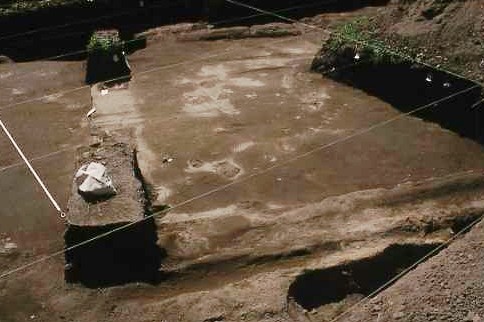
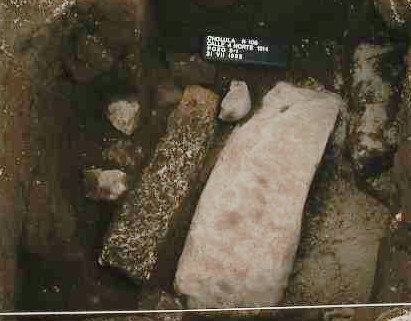
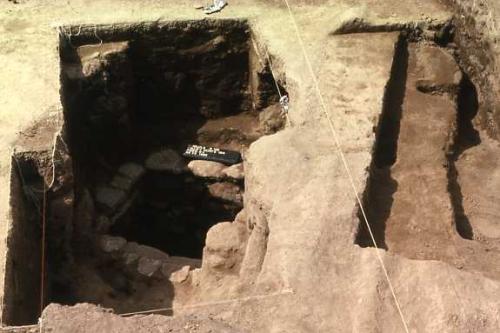
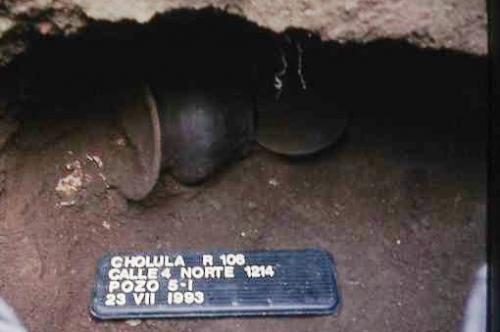
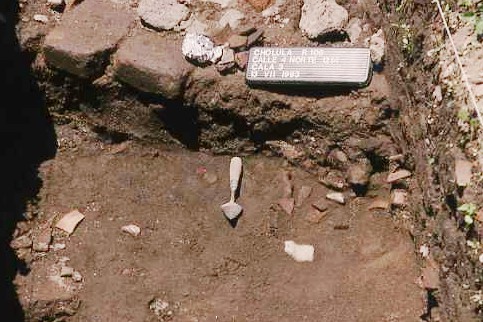
ANALYSIS AND DISCUSSION
Artifacts from beneath the house floor included ceramics, figurines, and obsidian blades, in addition to probable grave goods. The depositional context of the fill probably represents disturbed primary deposits (offerings) in addition to secondary deposits of refuse mixed with dirt fill that was redeposited at the time that the house floors were built up and the crypt was initially filled (cf. Schiffer 1987). Thus the mixed fill context includes objects relating to the systemic context of the household (offerings) as well as other material that predates the crypt construction but probably comes from the immediate vicinity, and perhaps relates indirectly to the yard deposits of the original household.
Similarities in material culture from these subfloor fill deposits suggest a tight temporal range, with minimal mixing from earlier or later periods. Stylistic comparisons with Teotihuacan indicate that the pottery and figurines best fit into the Late Tlamimilolpa/Early Xolalpan phases, ca. 400-550 c.e. Since the Classic period sequence for Cholula is poorly understood, these remains form a basis for further refinement of the chronology. Four C14 samples were analyzed by the INAH lab2, and the dates are reported in calibrated form at 1-sigma of deviance. Samples from just above the packed earth floor in Pozos 2-1 and 5-2 were dated at 460+61 CE. and 371+67 CE, respectively. A sample from above the tomb slabs in Pozo 5-1, and therefore relating to the intrusive burial, dated to 522+35 CE. A final sample was associated with the obsidian workshop, and dated to 411+49 CE. Based on these dates it is likely that the domestic complex was first occupied between 350-450 CE., with the final construction (the intrusive burial followed by Floor 1) dating to 500-550 CE.
The predominant ceramic types found in subfloor contexts (Table 1) were Tepontla Burnished Gray, representing about 50% of the assemblage, and a heretofore unidentified tannish orange type, designated Acozoc Tan/Orange, that made up an additional 28% of the total. Teotihuacan Thin Orange and a variety of local imitations constituted under 10% of the sample. Decorated pottery was rare, with the most common element being pattern burnishing on Tepontla Burnished Gray, usually in a diagonal criss-cross design (Fig. 9). This motif in addition to the use of nubbin supports suggests a relative date within the Tlamimilolpa phase at Teotihuacan (Charles Kolb, personal communication).

Figure : Tepontla bowls from burial
Figurine styles are also very similar to Teotihuacan forms, and again are associated with the Tlamimilolpa phase (Fig. 10). As is common among household assemblages of figurines, however, earlier forms were also present, representing styles similar to Tzacualli and Miccaotli phases at Teotihuacan. These may be explained either as heirlooms, random finds collected and curated by members of the household (perhaps children), or as the result of mixing. Comparison of the relative frequency of figurines in the subfloor contexts, based on count per 1000 rim sherds (c.f. Brumfiel 1982), indicates that the tomb fill contained an unusually high number of examples (n=30, or equivalent to 174/1000). While other collections are unavailable for comparison, this data suggests that figurine fragments may have been selected for inclusion in the tomb deposit as offerings.
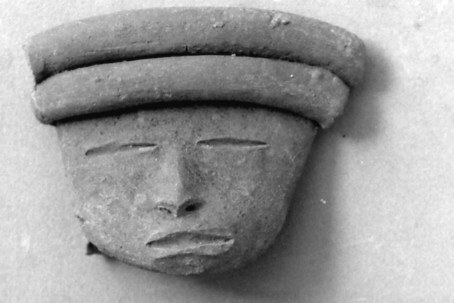

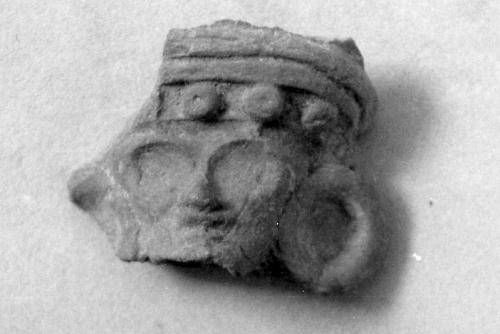
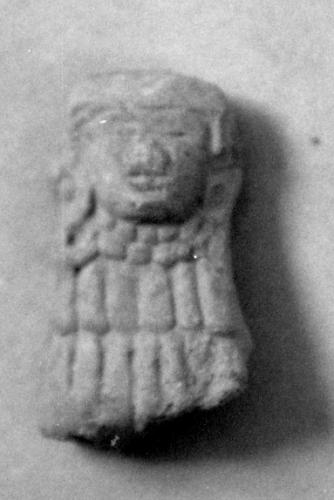

Figure 10: Figurines from Classic period contexts
Obsidian from beneath the house floor included a high proportion of green obsidian from the Pachuca Cerro de las Navajas source (63%) (Edelstein 1995). Other obsidian types indicated that the Zaragoza and Pico de Orizaba sources were also exploited. Analysis of the obsidian refuse from the workshop outside the house wall indicates that green obsidian was the principal type being processed (98%), and that at least some of the production included obsidian eccentrics, but a more significant task was in core preparation and blade production. Since the Pachuca obsidian source was possibly controlled by the Teotihuacan polity during the Classic period (Spence 1981; Santley 1983), the prominence of green obsidian may indicate trade interaction. Evidence for macro-core preparation, a relatively early stage in blade production, suggests that these Cholulteca artisans procured unrefined obsidian, and may therefore have been able to circumvent the Teotihuacan redistribution network (Edelstein 1995).
Based on the artifact analysis, strong ties with Teotihuacan can be suggested: 1) similar figurine types may imply shared domestic ritual; 2) the high incidence of green obsidian may imply participation in a Teotihuacan-dominated exchange network; 3) similarities between Tepontla Burnished Gray and Teotihuacan gray wares could relate to common ethnic heritage, and 4) the relatively high frequency of Thin Orange may indicate status and/or the desire to emulate Teotihuacan elites.
On the other hand, there are some significant differences between this household compound and what is known of contemporary Teotihuacan. The orientation of the house was 24o east of north, corresponding to the urban grid of Cholula and the Great Pyramid, but distinctly different from that of Teotihuacan (Tichy 1981). If building orientation relates to a state level religious ideology, then the architects of this household were conforming with Cholula in contrast to Teotihuacan.
Secondly, the degree of elaboration in tomb architecture from R-106 is not found at Teotihuacan, where burials are usually placed in small holes into the tepetate subsoil beneath floors or patios (Rattray 1992; Serrano 1993). Furthermore, as a secondary burial Individual #2 differs from Teotihuacan mortuary practices where primary burials predominate. The presence of greenstone beads with the deceased conforms to Teotihuacan practice, but is also typical of pan-Mesoamerican mortuary practice. In Aztec religion a greenstone placed in the mouth of the deceased represented the heart (Sahagún 1950-82, Book 3:45).
A final distinction of the R-106 assemblage is the notable absence of some of the ritual paraphernalia typically associated with Teotihuacan. Floreros, candelarios, and elaborate incensarios decorated with mold-made appliqués are defining characteristics of domestic ritual at Teotihuacan. These were not found at R-106, and are generally rare in Cholula contexts (Dumond and Müller 1972). This suggests the possibility that at least some domestic rituals were not shared. If, as Berlo (1984: ) suggests, complex incensarios related to the Teotihuacan imperial state, then Cholula may have been outside of its politico-religious sphere.
CONCLUSION
The R-106 site is but one residential context out of many relating to Classic period Cholula, and interpretations must be viewed as tentative until more examples can be added to the sample universe. It does, however, provide the best information relating to domestic contexts yet recovered for the Classic period, and is therefore an important data set for beginning the exploration of cultural practice. As indicated by the preceding discussion, the R-106 site permits initial interpretations of religious and mortuary practices, ethnicity, and economic relations.
What does the R-106 household compound tell us about Late Classic Cholula and its relationship with Teotihuacan? This context does support hypotheses that suggest economic, religious, and ethnic links between the two centers. On the other hand, important differences are also revealed, possibly relating to state level cosmology and political boundaries. Additional contexts are needed to clarify and expand on these similarities and differences. What is clear, however, is that until Cholula is addressed as a separate entity rather than as simply a clone of Teotihuacan, its particular culture history will continue to be obscured in the shadows of its Mexican neighbor.

